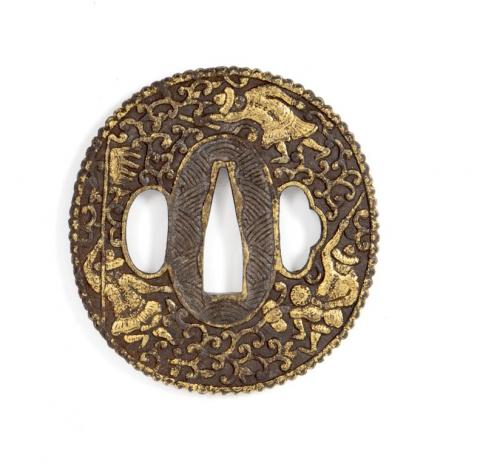Tsuba Namban
Ferro fundido, ouro e prata
Japão, Sec. XVII
Dim.: 7 × 7 cm
Prov.: R. Quintela, Lisboa
Namban tsuba
Wrought iron, gold and silver
Japan, 17th century
Dim.: 7 x 7 cm
Prov.: R. Quintela, Lisbon
17th century wrought iron (tetsu) Namban tsuba, shaped as a jagged edge elongated disc (naga maru-gata), and decorated in sophisticated gold and silver inlays. On the centre of the composition three aligned orifices framed in raised gold fillets, for fitting the Japanese sword (nihontö) in the centre (nakago hitsu), the Kogai on the right and the Kozuka on the left.
The central oval raised frame (seppa-dai) decorated with delicately chiseled interlacing waves, having to the right an elegant long tailed dragon and to the left a clearly European dancing figure within a field of Namban floral Karakusa scrolls. On the reverse three similar dancing figures on an identical background.
The iconography of this tsuba alludes to the “Dance of the Golden Dragon”, an important aspect of Japanese culture inherited from the Chinese tradition. The Japanese dragon, although physiognomically different from other oriental dragons, has maintained the attributes and symbolism of its Chinese counterparts.
Tsuba Namban do século XVII em ferro forjado (tetsu) de forma circular alongada (naga maru-gata) com aro dentado, apresentando motivos tauxiados em ouro e prata. Encerra três aberturas funcionais, delimitadas por filetes em ouro, que suportam respectivamente, a espada japonesa (nihontö) integrada ao centro (nakago hitsu) e complementada, a direita por orificio para Kogai e a esquerda para Kozuka.
A moldura (seppa-dai) do orifício central é decorada e cinzelada em ondas entrelaçadas. À esquerda, um dragão de grande cauda, e no lado oposto, encimado por nuvem, uma figura dançante europeia, rodeados por enrolamentos vegetalistas Namban Karakusa — ramos enrolados de várias plantas. No reverso do guarda-mão três dançarinos, igualmente vestidos à europeia, estão inseridos no mesmo modelo decorativo.
Iconograficamente, os motivos que decoram este guarda-mão, lembram a “Dança do Dragão” dourado, que se tornou importante na cultura japonesa, herdada da tradição chinesa. O dragão japonês, ainda que tenha traços fisionómicos diferentes dos outros dragões orientais, possui simbolismo e atribuições em tudo semelhantes aos chineses.
- Arte Colonial e Oriental
- Artes Decorativas
- Diversos

